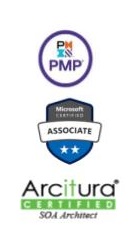Welcome to Vishwa's Blog
A digital realm of an Architect, where innovative solutions converge with business excellence.
With over 25 years of hands-on experience in Software Development, I am a seasoned Senior Solutions Architect specializing in crafting robust, scalable, and future-ready solutions that drive organizations toward their strategic objectives.
As a visionary leader in technology, I am dedicated to driving impactful innovation and architecting transformative solutions that empower organizations to thrive in an ever-evolving digital landscape. With an unwavering commitment to excellence, collaboration, and forward-thinking strategies, I aim to shape the future of technology and foster meaningful change that creates lasting value for businesses and society. My expertise lies in architecting, designing, and developing software solutions using industry-standard patterns, ensuring optimal performance, high availability, security, and reliability. I bring extensive experience in API development, microservices architecture, and database management across both on-premises and cloud environments.
Let's embark on your digital transformation journey together...
Expertise: Microsoft Technology & FinTech Industry
Architecture Patterns
Cloud Platforms
Messaging Systems
Development Tools
DevOps Tools
Development Methodologies
Operating Systems
- Microservices (MSA)
- Resource Oriented (ROA)
- Service Oriented (SOA)
- Object Oriented (OOA)
- N-Tier (NTA) & Layered
- Event Driven (EDA)
- Client Server (CSA)
Cloud Platforms
- Microsoft Azure
- Amazon Web Services (AWS)
Messaging Systems
- RabbitMQ
- Service Broker
Development Tools
- Visual Studio (Code)
- SQL Server Management Studio
- MySQL Workbench
- Another Redis Desktop Manager
DevOps Tools
- GitHub, Actions
- Git, Docker, YAML
- Azure DevOps
- Bitbucket
- Team City
- Jira, Trello
Development Methodologies
- Agile
- Scrum
- Waterfall
Operating Systems
- Windows
- Linux
Frameworks
API/Service Styles
Reporting Tools
Databases
Languages
- .NET (Core) & .NET Framework
- ASP.NET
- Web Forms
- Web API
- MVC
- Razor Pages
- Blazor
- Entity Framework Core (EFC)
- Windows Comm. Foundation (WCF)
- MAUI (Multi-platform App UI)
- xUnit
- Vue.js
- Bootstrap
API/Service Styles
- REST
- SOAP
- GraphQL
- gRPC
- XML/JSON-RPC
Reporting Tools
- SQL Server Reporting Services (SSRS)
Databases
- Relational
- MS SQL Server
- MySQL
- SQLite
- NoSQL
- Redis
- MongoDB
Languages
- Programming
- C#
- VB
- SQL
- Scripting
- JavaScript
- VbScript
- PowerShell
Major Implementations
Major Projects
Major Modules
- Microservices
- Modularization
- Multi-tenancy
- Diverse APIs & API Gateway
- Architecture & Design Patterns
- Process & Performance Optimization
- Refactor, Revamp & Redesign
- System Modernization
- Cloud Migration/Adoption
- DevOps, GitHub & AWS Migration
- International Expansion
- Multi Product System
- Database Management
Major Projects
- Loan Management System
- Short Term Loan
- Installment Loan
- Line of Credit
- Application Control System
- Unified API Gateway
Major Modules
- Application Processing
- Document Management
- User Management
- Customer Management
- Underwriting Engine
- Smart Origination Process
- Third Party Integrations
- Payment Management
- ACH
- Card
- Check
- Cash
- Money Order
- Settlements
- Auditing & Logging
- Automation
- Reporting
About Me

Vishwa Mohan Kumar Marietta, GA
Sr. Solutions Architect
MBA, PMP®, MCP - Azure, SOA Architect
